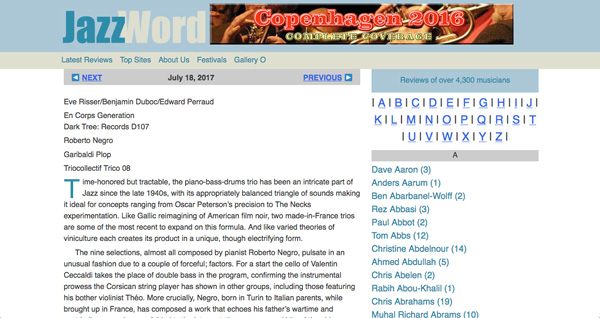• Chronique par Ken Waxman sur JazzWord (18 Juillet 2017)
Time-honored but tractable, the piano-bass-drums trio has been an intricate part of Jazz since the late 1940s, with its appropriately balanced triangle of sounds making it ideal for concepts ranging from Oscar Peterson’s precision to The Necks experimentation. Like Gallic reimagining of American film noir, two made-in-France trios are some of the most recent to expand on this formula. And like varied theories of viniculture each creates its product in a unique, though electrifying form.
The nine selections, almost all composed by pianist Roberto Negro, pulsate in an unusual fashion due to a couple of forceful; factors. For a start the cello of Valentin Ceccaldi takes the place of double bass in the program, confirming the instrumental prowess the Corsican string player has shown in other groups, including those featuring his bother violinist Théo. More crucially, Negro, born in Turin to Italian parents, while brought up in France, has composed a work that echoes his father’s wartime and post-bellum experiences. Added to the interpretations are a sound bite of the older man reminiscing on the concluding “Rosina cavatappi”, plus on the appropriately titled “1944” a scratchy recording of “Le Marche de Menilmontant”. Unassuming drummer Sylvain Darrifourcq rounds out the band.
As early as “Suole di gomma Vibram” the hectic concept of heroism and endurance is established by the writing of the pianist, who also works with a theatre company, as kinetic keyboard tones accelerate along with string bumping from the cellist and hard drum accents, leading to a concept both foot tapping and dramatic. Evolving with alternating elevated and subdued textures, conjoined pieces such as “Farina, crusca e voto alla Madonna” and “Camouflage, parte seconda” swing enough with a keyboard combination of glissandi and hunt-and-peck focus, to work out of the Red Garland-Wynton Kelly bag, while latterly post-modern reconstitutions take the merry melodies apart with dynamic piano key slaps and knife-like whines from cello strings.
Father Negro’s reminiscences, followed by protracted silences and quiet connective tissue of key sprinkles and string vibrations, operate like a film dissolve, leaving the listener yearning for more music. Yet the defining climax arrives with the penultimate “Grilletto”. Hearty cymbal sizzles intensify the dramatic earnestness of the piece which repurposes the melody to reflect power and passion via Negro’s kinetic rolls and Ceccaldi’s buzzing counterpoint.
The piano and bass playing on En Corps Generation are similarly intense and passionate with Eve Risser and Benjamin Duboc respectively, playing those roles, with drummer Edward Perraud having mastered everything from Rock-directed to microtonal sounds confirming his necessary intersection in this triangular outflow. Recorded in concert this second outing of the trio, consisting of three French players who have distinguished themselves in situations ranging from microtonal to raucous and from orchestral to solo, has as its focal point the nearly 33-minute “Des Corps”. Unfolding as slowly as a blossom in real time, the pianist’s initial out-of-tempo exposition is quickly deconstructed into brittle key chopping as all the while bow slides from Duboc and unexpected accents from Perraud provide thematic continuum. Midway through, Risser inventively breaks up the time with a series of clanking patterns and persistent key fanning until knuckle-duster-like pops from the drummer leads to woody, pressurized theme extension from the bassist. This strategy leads to a crescendo of ring-around-the-rosy impulses as each passes the narrative along like participants in a relay race. Eventually as the bassist brings cello-resembling, below-the-scroll slides into the company of broad keyboard expression alongside occasional percussion crunches, the three expel a nimble upwardly mobile finale. More theatrical, “Des Âmes”, the encore heightens the action with buzzing string scrubs, relentless percussion clattering plus glissandi that suggests a centipede racing across the piano keys. With this interaction both slick and solid as the piano and double bass lock into a groove the concluding sequence turns agile and humorous retaining good feeling among distilled bravura exhibited by players at the top of their game.
As long as trios such as these are around it appears that the varieties of sounds produced by piano-drums-and low-pitched string combos remain limitless.
• • • • • • • • • • • • • • • • • • • • • • • • • • • • • • • • • • • • • • • • • • • • • • • • • • • • • • • • • • • • • • • •

Sorry, the comment form is closed at this time.